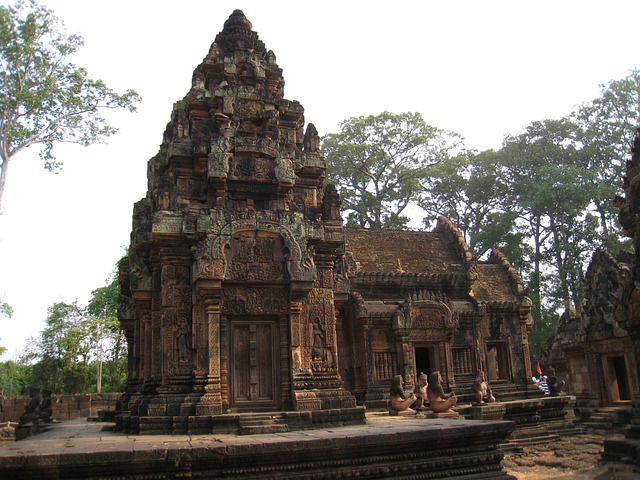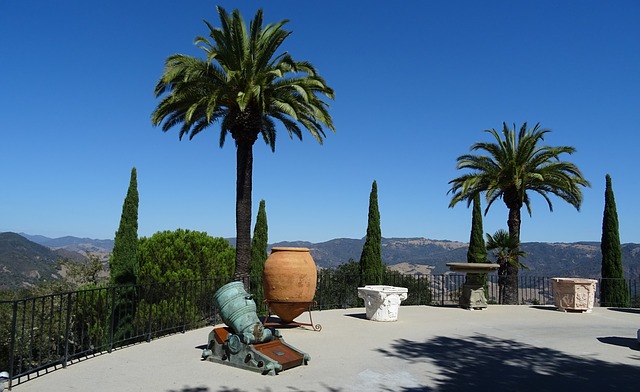“It is of such extraordinary construction that it is not possible to describe it with a pen.” These are the words of António da Madalena, a Portuguese monk who, in 1586, was one of the first Westerners to marvel at the magnificent temple of Angkor Wat. In the years since, visitors have been awed by the 500-acre site’s grand towers, detailed bas-relief decorations, and the impressive moat surrounding it all. The name Angkor Wat, which means Temple City, is a fitting description for what is thought to be the largest religious monument in the world.
Dating back to the early 12th century, Angkor Wat was constructed during the reign of the Khmer king Jayavarman II. Built from sandstone blocks by 300,000 workers and 6,000 elephants, it is considered the finest example of Khmer architecture. The main temple, which Jayavarman dedicated to the Hindu deity Vishnu, is thought to represent Mt. Meru, home of the Hindu gods. While Angkor Wat was eventually transformed into a Buddhist temple, to this day it continues to serve not only as a spiritual and religious center for the Cambodian people, but also as a symbol of their country. Of course, it is also the top destination for tourists visiting the Southeast Asian kingdom.
Travelers planning to visit Angkor Wat usually base themselves in the town of Siem Reap, four miles south of the main temple.
Since the site can get very crowded with tourists, especially during peak season from November to March, it’s best to rise before dawn and be there when the grounds open around 5:30 a.m. The humidity is also the lowest at this hour. Take your time exploring Angkor Wat—there’s so much to take in. Chances are, you’ll be at a loss for words, just like António da Madelana.
「此建築之獨特無以倫比,其超絕非凡,筆墨難以形容。」這句話出自安東尼奧達馬達雷那之口,這位葡萄牙修士於 1586 年成為最早對吳哥窟這座宏偉廟宇表達讚嘆之意的西方人士之一。自此以後的數百年來,到此一遊的旅客莫不對這佔地五百 多英畝遺址中的高聳尖塔、精雕細琢的浮雕裝飾、以及圍繞一切的巨大護城河等,感到驚歎不已。對於被認為是世上最大宗教遺跡的吳哥窟而言,其名稱的意思─廟宇之城,可說是最適合不過的形容詞了。
吳哥窟的歷史可回溯至 12 世紀初期,於高棉國王闍耶跋摩二世的統治期間建成。吳哥窟藉著三十萬名工人及六千頭大象之力、由一塊塊砂岩打造而成,被認為是高棉建築的巔峰代表。其主殿是闍耶跋摩旨在獻給印度教神祉毗濕奴,同時也被認為用來代表印度教眾神的居所─須彌山。雖然吳哥窟後來轉而變成佛寺使用,不過至今仍被柬埔寨人民視為其精神與宗教的中心、同時也是該國的象徵。當然,這裡也是拜訪這個東南亞王國之旅客首選的旅遊去處。
計畫拜訪吳哥窟的遊客通常會住宿在主殿南方四英里的暹粒市。由於整個遺址容易擠滿遊客,特別是在 11 月到 3 月的旺季期間,因此最好在日出前就起床,然後在早上五點半開放參觀時就抵達該處,此時的濕度也是一天當中最低的。您不妨好整以暇地探索吳哥窟,畢竟要欣賞的事物實在太多了。很有可能的情況是,就如同安東尼奧達馬達雷那一樣,您也會難以找到形容之詞。
VOCABULARY
1) extraordinary (a.) 非凡的,特別的
2) construction (n.) 建造(物),建築(物) construct (v.)
3) monk (n.) 和尚,修道士
4) marvel (at) (v.) 對⋯感到驚奇
5) magnificent (a.) 壯麗的,宏偉的
6) awe [O] (v.)(使)敬畏
7) acre (n.) 英畝
8) decoration (n.) 裝飾,裝飾品
9) moat (n.) 護城河,壕溝
10) fitting (a.) 貼切的,合適的
11) reign (n.) 在位,統治
12) dedicate (to) (v.) 奉獻,獻給⋯
13) deity (n.) 神,女神
14) eventually (adv.) 最後,終究
15) transform (v.) 改變,改建
16) spiritual (a.) 精神上的,心靈的
17) base (v.) 以⋯為基地
18) peak (a./n.) 高峰(的),頂端(的),,peak season 即「旺季」
19) humidity (n.) 濕度,濕氣
20) take in (phr.) 觀賞
Tongue-tied No More
at a loss for words 詞窮
這句片語是指「詞窮、想不出要說什麼」,通常用來形容因驚訝 或困惑而說不出話。
A: What did you say when Debbie told you she was breaking up with you?
當黛比說她要跟你分手的時候,你怎麼說?
B: Nothing. I was at a loss for words.
什麼都沒說。我無言以對。
photo credit: fefechen
除了上面文章內容,你還可以參考下方更多相關英文教學。
更多英文閱讀
如果你喜歡學習各種英文文法、英文片語、口語英文、英文單字等等,歡迎追蹤全民學英文的 FB 粉絲專頁、Instagram,以及Line 官方帳號。







